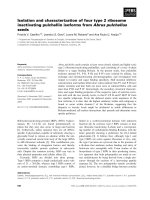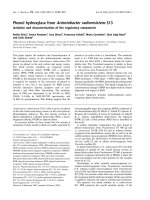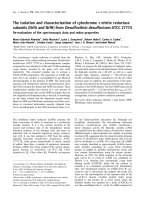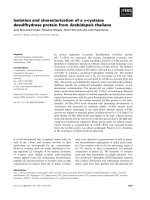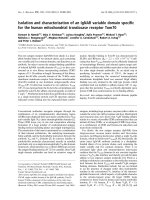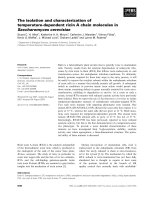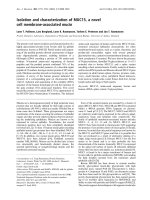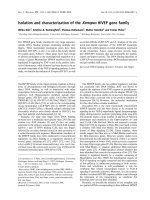Isolation and characterization of fungi associated with spolilage of post harvest mango fruits vended in markets of gia lam district (khóa luận tốt nghiệp)
Bạn đang xem bản rút gọn của tài liệu. Xem và tải ngay bản đầy đủ của tài liệu tại đây (3.33 MB, 78 trang )
VIETNAM NATIONAL UNIVERSITY OF AGRICULTURE
FACULTY OF BIOTECHNOLOGY
----------------------
UNDERGRADUATED THESIS
ISOLATION AND CHARACTERIZATION OF FUNGI
ASSOCIATED WITH SPOILAGE OF POST-HARVEST
MANGO FRUITS VENDED IN MARKETS OF GIA LAM
DISTRICT
Student’s name
: Do Huyen Trang
Student’s code
: 610683
Major
: Microbial biotechnology
Supervisor
: Nguyen Thanh Huyen, MSc
HANOI, 2/2021
COMMITMENTS
I hereby declare that all the data and results in this thesis are honest and have never
been used in any report yet.
I also assure that the information cited in the thesis is indicated the origin and all
the help is thankful.
Hanoi, 1st February, 2021
Student
Do Huyen Trang
i
ACKNOWLEDGEMENTS
First of all, I would like to express my appreciation to the directory of Vietnam National University of Agriculture, board of deans and lectures in the Faculty of Biotechnology for giving me a chance to study in a professional environment that provided me the
sufficient knowledge throughout four and a half academic years.
In the process of doing my thesis, there are many people who help me bring this
work to existence, but the most influential and inspiring person I would like to extend a
special thanks is my supervisor, MSc. Nguyen Thanh Huyen, who in the past 6 months
has helped me to accomplish more than I thought possible and inspired me to experience
the research and patiently correct my writing.
I would like to express my deep gratitude to all teachers from the Department of
Microbiology, Faculty of Biotechnology, who encouraged me to enhance knowledge and
help me get orientation of my thesis.
I would like also thank all my friends, who were with me up until this point, simultaneously motivate me to accomplish more through their examples.
Last but not least, I’d like to thank my parents who encouraged me to try my best
until the job is done, and who never ceased in providing me with the support I needed
Hanoi, February 1st , 2021
Student
Do Huyen Trang
ii
TABLE OF CONTENTS
COMMITMENTS ............................................................................................................i
ACKNOWLEDGEMENTS ............................................................................................ii
TABLE OF CONTENTS .............................................................................................. iii
LIST OF ABBREVIATIONS ........................................................................................vi
LIST OF TABLES ........................................................................................................vii
LIST OF FIGURES ..................................................................................................... viii
ABSTRACT .................................................................................................................... x
CHAPTER I: INTRODUCTION .................................................................................... 1
1.1. Introduction .............................................................................................................. 1
1.2. Objective................................................................................................................... 2
1.3. Requirement.............................................................................................................. 2
CHAPTER II: LITERATURE REVIEW ........................................................................ 3
2.1. General introduction of mango................................................................................. 3
2.1.1. Origin and distribution .......................................................................................... 3
2.1.2. Description ............................................................................................................ 8
2.1.3. Composition of mango cultivars ......................................................................... 11
2.2. Common diseases of mango fruits in the world and in Vietnam ........................... 16
2.2.1. Anthracnose ......................................................................................................... 16
2.2.2. Stem end rot ......................................................................................................... 18
2.2.3. Transit rot ............................................................................................................ 19
2.2.4. Aspergillus rot ..................................................................................................... 20
2.3. Control of spoilage and ripening in mango fruits................................................... 22
2.3.1. Chemical control ................................................................................................. 22
2.3.2. Biological control ................................................................................................ 23
CHAPTER III: MATERIAL AND METHODS ........................................................... 27
3.1. Materials ................................................................................................................. 27
3.1.1. Samples collection ............................................................................................... 27
3.1.2. Chemicals, instruments and equipment ............................................................... 27
3.1.3. Location and time studies .................................................................................... 27
iii
3.1.4. Medium components ........................................................................................... 27
3.2. Research content ..................................................................................................... 28
3.3. Methods .................................................................................................................. 29
3.3.1. Method of isolation and purification of fungal pathogens from rotten mango fruit ... 29
3.3.2. Method of artificial infection............................................................................... 29
3.3.3. Method of studying biological characteristics..................................................... 29
3.3.4. Optimal growth conditions of fungi .................................................................... 30
3.3.5. Method of testing enzymatic activity .................................................................. 30
3.3.6. Molecular identification of fungal species .......................................................... 31
CHAPTER IV: RESULTS AND DISCUSSION .......................................................... 33
4.1. Isolation of fungal pathogens causing spoil in post-harvest mango fruits ............. 33
4.2. Artificial infection .................................................................................................. 34
4.3. Characterization of isolated fungal strains ............................................................. 37
4.3.1. M1 strain .............................................................................................................. 37
4.3.2. M2 strain .............................................................................................................. 38
4.3.3. M3 strain .............................................................................................................. 40
4.4. Effect of different media on the growth of isolated fungal strains......................... 41
4.5. Effect of different pH on the growth of isolated fungal strains.............................. 43
4.6. Effect of different temperatures on the growth of isolated fungal strains. ............. 45
4.7. Testing extracellular enzyme activity..................................................................... 47
4.7.1. Producing chitinase activity of isolated fungal strains ........................................ 47
4.7.2. Producing cellulase activity of isolated fungal strains ........................................ 48
4.7.3. Producing pectinase activity of isolated fungal strains ....................................... 50
4.8. Phylogenetic analysis ............................................................................................. 51
4.8.1. DNA extraction of isolated fungal strains ........................................................... 51
4.8.2. PCR amplification of three isolated strains ......................................................... 51
4.8.3. Phylogenetic analysis of M1 strain. .................................................................... 53
4.8.4. Phylogenetic analysis of M2 strain. .................................................................... 54
4.8.5. Phylogenetic analysis of M3 strain. .................................................................... 56
CHAPTER V: CONCLUSION AND SUGGESTION ................................................. 58
iv
5.1. Conclusion .............................................................................................................. 58
5.2. Suggestion .............................................................................................................. 58
REFERENCE ................................................................................................................ 59
v
LIST OF ABBREVIATIONS
Abbreviation
Explanation
PDA
Potato Dextrose Agar
SDA
Sabouraud Dextrose Agar
MEA
Malt Extract Agar
CDA
Czapek Dox Agar
ISP
International Streptomyces Project
et al
et alia
vi
LIST OF TABLES
Table 2.1: Acreage and yield of mango in different regions in Vietnam in
2017 ................................................................................................................... 6
Table 2.2: Nutritional value per 100g in Mango. .................................................... 12
Table 2.3: Nutritional value of seed kernel in Mango. ........................................... 15
Table 2.4: Nutritional value of leaves in Mango. .................................................... 16
Table 4.1: The presence of fungi strains in three chosen markets. ....................... 33
Table 4.2: Morphological characterization of three isolated fungal strains. ........ 33
Table 4.3: Time to form hyphae, sclerotium, conidiophores, conidia and
chlamydospore ................................................................................................ 40
vii
LIST OF FIGURES
Figure 2.1: Mango production worldwide from 2000 to 2018 (in million
metric tons)................................................................................................ 4
Figure 2.2: World's top 25 largest mango producers in 2018 (tonnes). ................ 5
Figure 2.3: Map of mango in Vietnam .................................................................. 7
Figure 2.4: Mango tree .......................................................................................... 9
Figure 2.5: Mango fruits........................................................................................ 9
Figure 2.6: Mangoes with different colours ........................................................ 10
Figure 2.7: Unripe mango and ripe mango ........................................................ 11
Figure 2.8: Anthracnose on mango fruits............................................................ 17
Figure 2.9: Colletotrichum gloeosporioides........................................................ 17
Figure 2.10: Stem end rot of mango caused by Lasiodiplodia theobromae ....... 18
Figure 2.11: Morphological characterization of Lasiodiplodia theobromae. ..... 18
Figure 2.12: Morphological characterization of Rhizopus stolonifer ................. 19
Figure 2.13: Transit rot of mango caused by Rhizopus stolonifer ...................... 20
Figure 2.14: Spoilage mango caused by A.niger. ............................................... 21
Figure 2.15: Morphological characterization of Aspergillus niger..................... 21
Figure 2.16: Products derived from prochloraz .................................................. 23
Figure 2.17: Bio-polymer film for preserving fruits. .......................................... 26
Figure 4.1: Isolated fungal strain from the postharvest spoiled mangoes .......... 33
Figure 4.2: Isolated samples of M1, M2 and M3 strain ...................................... 36
Figure 4.3: Re-infection of isolated fungal strain (M1, M2, M3) in mangoes
fruit and control sample on the 4th day.................................................... 37
Figure 4.4: Microscopic observation of the isolated fungal strain-M1............... 37
Figure 4.5: Microscopic observation of the isolated fungal strain-M2............... 39
Figure 4.6: Microscopic observation of the isolated fungal strain-M3............... 40
Figure 4.7: Fungal strain-M1 in different media on the 5th day .......................... 41
Figure 4.8: Fungal strain-M2 in different media on the 5th day .......................... 42
viii
Figure 4.9: Fungal strain-M3 in different media on the 2rd day ........................ 42
Figure 4.10: Fungal strain-M1 in different pH on the 5th day ............................. 43
Figure 4.11: Fungal strain-M2 in different pH on the 5th day ............................. 44
Figure 4.12: Fungal strain-M3 in different pH on the 2rd day ............................ 44
Figure 4.13: Fungal strain-M1 in different temperatures on the 5th day ............. 45
Figure 4.14: Fungal strain-M2 in different temperatures on the 5th day ............. 46
Figure 4.15: Fungal strain-M3 in different temperatures on the 2rd day ............. 46
Figure 4.16: Chitinase activity of the isolated strains based on their clear
zones around the wells after a day’s incubation ..................................... 48
Figure 4.17: Cellulase activity of the isolated strains based on their clear
zones around the wells after a day’s incubation ..................................... 49
Figure 4.18: Pectinase activity of the isolated strains based on their clear
zones around the wells after a day’s incubation ..................................... 50
ix
ABSTRACT
The purpose of this research is to determine and study the biological characteristics
of pathogenic fungal strains in post-harvest spoiled mango fruits, we isolated, purified of
fungal strains from spoiled pieces of mango, then re-infected the isolated fungal strains
into the healthy mango to select fungal strains capable of causing disease. These selected
fungal strains were used to study further experiments, including: research morphological,
biochemical characteristics and evaluate the effect of culture medium, pH and temperature
to the growth and development of isolated fungal strains.
From the infected sample, 3 fungal strains (M1, M2 and M3) were isolated that
have potential to cause disease in mango, verified by artificial infection. Through studying
the optimal growth conditions of fungal strains, it proves that M1 grows well on SDA and
PDA, the fungal strains M2 and M3 showed good growth of mycelium on PDA and MEA.
In terms of temperature, M1 and M3 grew suitable around 30-37°C whereas the fastest
colony growth of M2 was obtained in temperature of 30°C. It was also found that M1
grows highest at pH 5.0. M2 strain showed good growth of mycelium at pH 7.0, 8.0 and
10.0. The suitable growth of M3 was obtained at pH 4.0, 6.0 and 10.0.
In terms of extracellular enzyme activity, it was found that M1, M2 and M3 can
produce pectinase; M1 and M2 have the ability to produce chitinase whereas only M1 can
produce cellulase among three isolated strains.
The isolated fungal strains were studied morphological characteristics. M1 showed
a branched-septate hyphae with colorless. Conidial heads are large, globose, dark brown,
becoming radiate and tending to split into several loose columns with age. Conidiophore
stipes are smooth-walled, hyaline or turning dark towards the vesicle. Conidia are globose
to subglobose, dark brown to black and rough-walled. M2 also showed a branched-septate
hyphae with colorless. Sclerotia are sub-ovoid, light-yellow, becoming pale brown as they
mature. Conidiophores produce both alpha-conidia and beta-conidia. M3 isolated showed
septate, branched hyphae. Not produce spores.
The isolated fungal strains were identified by sequencing of the internal transcribed
spacers (ITS) region and 16s rRNA. The causal fungal strains were identified as A. Niger
(M1), Phomopsis sp. (M2) and L. Theobromae (M3).
x
CHAPTER I: INTRODUCTION
1.1. Introduction
Mango is one of the most important and popular fruits in Vietnam, which is considered as the ''king of fruits''. This fruit has very high economic efficiency. It can be sold
at a price from 25 to 30 thousand/kg, meanwhile off-season mango price is about 50 thousand/kg. Mango tree has high revenue of about 350-450 million/ha. In addition, it can be
intercropped with many other types of trees with low canopy to increase income per farming unit. It can be seen that mango is one of the crops of high economic value and optimal
yield. Moreover, bringing profits and jobs to people out of poverty create an advantage
impact on the development of Vietnam (Farmtech VietNam, 2017). Extension of mango
cultivation has also occurred to several other parts of the world including Africa, the
Americas and the Caribbean region (Vietmeyer, 1986). Day by day consumption of mango gets popularity in the developed countries (Diedhiou et al., 2007).
In accordance with several studies, it was reported that different parts of mango
contains phenolic compounds, polyphenols, phenolic acids, hydrocarbons, fatty acid, amino acids and triterpenes etc. and these chemical compounds present in the mango exhibited various biological activities like anticancer, anti-inflammatory, antidiabetic, antioxidant,
antibacterial, antifungal, anthelmintic, gastroprotective, hepatoprotective, immunomodulatory, antiplasmodial and antihyperlipidemic effects (Ediriweera et al., 2017).
However, the production of mangoes becomes inadequate due to losses in the field,
during storage, transit or trans-shipment, during handling processes of the crop from the
grower to the whole sale dealer and to retailer and finally to consumers (Chukwuka et al.,
2010; Barth et al., 2013). During storage stage, mangoes are easily spoiled. The high concentration of various sugars, minerals, vitamins, amino acids, and low pH are the major
factors that contribute to the successful growth and survival of various saprophytic and
parasitic fungi (Bhale, 2011). The most frequent pathogenic fungi isolated from mangoes
are Colletotrichum gloeosporioids, Botryodiplodia theobromae, Dothiorella dominican,
D. Mangiferae, Phomopsis mangiferae and Aspergillus niger (Sangchote, 1987). Species
belonging to Rhizopus, Aspergillus, Colletotrichum, Botrydiplodia, Phomopsis and Diplodia have been reported to cause rotting of fruit during transit, storage and marketing inju-
ries (Dasgupta and Bhat, 1946; Kanitkar and Uppal, 1939; Thakur and Chenulu, 1970;
Laxinarayan and Reddy, 1975; Thakur, 1972). Fungal spoilage created unpleasant odours
and flavor, reduced quality and caused foodborne disease (Rawat, 2015).
Facing the reality of reduced mango productivity and also creating negative effects
on the economy are occured. Current study was undertaken to isolate, determine the morphological and biochemical characteristics of fungal strains associated with post-harvest
mango fruits in variety markets in Gia Lam district. Hence, the most effective direction of
control for the isolated fungal strains in fruits can be found.
1.2. Objective
Isolation, determination the morphological and biochemical characteristics of
pathogenic fungi associated with spoilage of mango fruits in the different markets of Gia
Lam district.
1.3. Requirement
Isolate and select of fungi associated with spoilage of mango fruit in the different
markets of Gia Lam district area.
Re-infect the fungi into the healthy mangoes.
Study biological characteristics of fungal strains causing spoilt on mango fruits:
morphology colony, mycelium and spore of fungus.
Evaluate of the ability of extracellular enzyme production of isolated fungal strains.
Examine some factors affecting on the growth of those fungal strains.
2
CHAPTER II: LITERATURE REVIEW
2.1. General introduction of mango
A mango (Mangifera indica L.) is a stone fruit produced from various species of
tropical trees, is a member of the family Anacardiaceae and belong to the flowering
plant genus Mangifera, cultivated mostly for their edible fruit (Morton, 1987) “Mangoes
are native to South Asia, especially eastern India, Burma, and the Andaman Islands, the
mango has been cultivated, praised and even revered in its homeland since Ancient times”
(Morton, 1987). It is the national fruit of India, and has been decided as the national tree
of Bangladesh (Bangladesh’s Fish Internet Newspaper, 2010). Mangifera indica L has also been distributed worldwide to become one of the most widely cultivated fruits in
the tropics.
2.1.1. Origin and distribution
a. Origin
Mangoes are native to South Asia, especially eastern India, Burma, and the Andaman Islands. Mangoes are grown in India from 4,000 to 6000 years. Hsuan-tsang (a Chinese Buddhist monk) appears to be the first person to bring the mango to the notice of
people outside India. Mangoes were taken on voyages to Malaya and eastern Asia in the
4th and 5th Centuries B.C by Buddhist monks. It is believed to have carried mangoes to
China by the 7th Century; to East Africa around the 10th Century AD; to the Philippines in
the beginning of the 15th Century. The rapidly spread of mangoes from South and Southeast Asia over the tropical and subtropical areas of the world was taken from the end of
the 15th Century onward. It was introduced to West Africa early in the 16th Century and
also into Brazil. After becoming established in Brazil, the mango was carried to the West
Indies, being first planted in Barbados about 1742 and later in the Dominican Republic. It
reached Jamaica in 1782; Hawaii in 1809; Mexico and America during the 19th Century
(Yadav and Singh, 2017). Afterward it started to gain popularity around the world. Today,
a large number of the popular varieties of mango grown around the world are derived
from the mango produced in Florida (USA). The geographic popularity of the mango was
essentially accomplished in the second half of the 19th century with its introduction to as
3
far away as Florida, Hawaii, Fiji, Queensland and Natal (Morton, 1987; Yadav and Singh,
2017).
The taxonomic classification of the common mango is:
Kingdom – Plantae
Class – Magnoliopsida
Phylum – Magnoliophyta
Order – Sapindales
Family – Anacardiaceae
Genus – Mangifera
Species – Indica
b. Distribution of mango in the world
In 2013, the global mango production reached around 43 million metric tons. This
figure increased significantly to around 55 million metric tons in 2018 ( Amber Pariona,
2018; Shahbandeh, 2020).
Source: Statista 2021
Figure 2.1: Mango production worldwide from 2000 to 2018 (in million metric tons)
4
India produced the highest mangoes all over the world during the years 2000-2018.
This figure reaches over 18 million tons, which is approximately 50% of the global mango
supply by the year 2018. Andhra Pradesh, Bihar, Gujarat, Karnataka, Maharashtra, and
Orissa are the six states producing mainly mango in India, although many other Indian
states also cultivate mangoes. “In total, India has about 2,309,000 acres dedicated to mango farming up to the year 2018” (Amber Pariona, 2018).
China and Thailand were the next largest producers with 4.77 and 3.4 million tons
of mango, respectively (Amber Pariona, 2018).
Source: (IHS market, 2020)
Figure 2.2: World's top 25 largest mango producers in 2018 (tonnes).
The price of mangoes varies according to the size, the variety, and other factors at
the wholesale level. The Free on Board price (FOB price) for all mangoes imported into
the US ranged from approximately $4.60 (average low price) to $5.74 (average high price)
per box (4kg/box) during 2018 reported by the United States Department of Agriculture
(NMB crop reports, 2019).
5
c. Distribution of mango in Vietnam.
Vietnam ranks 13th in terms of the largest mango production in the world with a
total mango-growing area of over 87,000 hectares and the mango yield of around 969,000
tons annually. Mangoes are one of the main tropical fruits grown in Vietnam and are distributed mainly in the Mekong Delta, accounting for 48.0% of the country's total mango
area. Binh Thuan, Ninh Thuan, Khanh Hoa and Binh Dinh provinces are the most grown
areas in central Vietnam in which Khanh Hoa is the highest mango production with 8,000
hectares (60 quintals/ 60 quintals / ha). In addition, Son La province grew the largest
mango in the north of Vietnam with 4,300 hectares (vntrade, 2016).
Consumption markets of mango in Vietnam: The majority of mangoes are consumed domestically, Vietnam only exports 4% of the total mango production. Border
trade export market is mainly China. In terms of official exports, the main export markets
of Vietnam today are South Korea (1,181 tons, accounting for 43% of Vietnam's total
mango exports), Japan (934 tons, accounting for 34%) and Singapore (186 tons, accounting for 7%) (vntrade, 2016).
Table 2.1: Acreage and yield of mango in different regions in Vietnam in 2017
Acreage
Number
Yield
Region
Hectare
%
Ton
%
1
Red River Delta
2.415
2.6
21.164
2.7
2
Northern Midlands and Mountains
12.195
13.1
28.723
3.6
3
North Central
1.675
1.8
8.364
1.1
4
South Central coast
13.054
14.1
73.798
9.4
5
Western Highlands
2.918
3.1
19.174
2.4
6
Southeast
17.765
19.2
129.460
16.4
7
Mekong River Delta
42.725
46.1
507.550
64.4
Total
92.746
100.0
788.233
100.0
Source: Department of Horticulture, Ministry of Agriculture and Rural Development
6
Source: (Thị trường Úc, 2016)
Figure 2.3: Map of mango in Vietnam
According to a report by the Agency of Foreign Trade under the Ministry of Industry and Trade, citing U.S. official figures, the value of mango imports rose 99.9% to $2.79
7
million compared to 2019. The average import price was $2,064.8 per tonne, up 6.7 compared with 2019 with fresh and frozen fruit. In terms of volume, Vietnam was the
12th largest mango import market for the U.S, accounting for 0.3% of the total. The Agency of Foreign Trade said that the US is a large market for mango in Vietnam, especially
fresh fruit. That is an opportunity for Vietnamese companies to expand. However, all
strict standards on farming, packaging and origin tracing must be ensured. Vietnam's first
batch of mango exports to the United States was exported in April 2019 (Vietnam Times,
2020).
2.1.2. Description
The tropical mango tree is erect with a broad, rounded canopy which may reach
from 30 to 38m in width and 30 to 40m and occasionally 54m in height, the largest of
which are emergent in the rainforests of South and Southeast Asia (Litz, 2009). The root
system descends to soil with a depth of 20 ft (6 in), spreading down to the soil. They have
long lives, some specimens still bear fruit while 300 years old. Mango leaves are evergreen, alternate, simple, 15–35cm (5.9–13.8 in) long, and 6–16cm (2.4–6.3 in) broad. The
leaves change rapidly from orange-pink to a dark, glossy red, then dark green when they
mature throughout their lives. Mature mango trees produce up to hundreds and even as
many as 3,000 to 4,000 small, yellowish or reddish flowers (monoecious, hermaphrodite,
or polygamous). The flowers produced in terminal panicles; each flower is small and
white with five petals with a mild, sweet fragrance (Morton, 1987). Over 500 varieties of
mangoes have been discovered, spoiling in the summer appears in almost all varieties
while some give a double crop. The period from flowering to ripen undergoes four to five
months.
8
Figure 2.4: Mango tree
Figure 2.5: Mango fruits
The ripe mango varies depending on cultivar in terms of size, shape, color, sweetness, and fruit quality. Different kinds of mango have different colours (yellow, orange,
red, or green) and shape (round, oval, or kidney-shaped) due to cultivar. According to different periods, mango ranged from 5–25cm in length; 140 grams to 2 kilograms in weight
per individual fruit. The fruit has a single flat, oblong pit that can be fibrous or hairy on
9
the surface, and does not separate easily from the pulp. The appearance of mango looks
like leather which is waxy, smooth, and fragrant with color ranging from green to yellow,
yellow-orange, yellow-red, or blushed. When fully ripe, they carry various forms of red,
purple, pink or yellow.
Ripe intact mangoes give off a distinctive resinous, sweet smell. Inside the pit 1–
2mm (0.039–0.079 in) thick is a thin lining covering a single seed, 4–7cm (1.6–2.8 in)
long. Mangoes have recalcitrant seeds which do not survive freezing and drying. Mango
trees grow readily from seeds, with germination success highest when seeds are obtained
from mature fruits.
Fruit development can be divided into four stages: (1) juvenile stage (up to 21 days
from the day of fruit set) leads to rapid cellular growth; (2) stage of maximum growth
(21–49days) results in cell enlargement and maturity; (3) maturation and ripening stage
(49–77days) during which respiration and ethylene production increases (the climacteric
stage of fruit ripening); and (4) senescence stage (77th day onwards), the post ripening
stage, during which the fruit is prone to microbial attack and decay (Tharanathan et al.,
2006). Mango fruits normally reach maturity about 4–5 months after flowering.
Figure 2.6: Mangoes with different colours
10
Figure 2.7: Unripe mango and ripe mango
There are 10 types of mangoes that are commonly grown and consumed in Vietnam, including: Hoa Loc mango, Thailand mango, Mangifera mekongensis mango (xoài
thanh ca), Australian mango, Mangifera indica (xoài tượng), blockchain mango (xoài cát
chu), xoài keo, xoài tứ quý, xoài giống đài loan đỏ, xoài bào tử, xoài thái.
2.1.3. Composition of mango cultivars
Fruits play a very important role in human nutrition by providing additional
sources of energy, necessary growth factors, carbohydrates, dietary fibers, and antioxidants, which are essential for maintaining normal health. Physicochemical and nutritional
characteristics (increasing during the process of ripening) decided the quality of any fruit.
Mango is a main source of sugars (reducing and nonreducing), carbohydrates, fats, vitamins, minerals, dietary fibers, antioxidants, tannins, polyphenols, pigments, and flavor
compounds with the high energy value of 250 kJ (60 kcal) per 100g of common mango
and thus is a commercially valuable food crop . Fresh as well as processed forms of mango fruit are an important part of the human diet.
In mango cultivars, protein content ranges approximately from 0.5 to 1%. The
amino acid content of the fruit varies depending upon the maturation level. For instance,
only alanine, arginine, glycine, serine, leucine, and isoleucine appear in the peak of maturation, while all other amino acids are present in trace amounts (Tharanathan et al., 2006).
The lipid content ranged from 0.75 to 1.7% for peel and 0.8 to 1.36% for pulp (Pathak and
Sarada, 1974) in which lipid contents of ‘Alphonso’ displayed a steep increase during rip-
11
ening (Gholap and Bandyopadhyaya, 1975). Elaborate analysis of fatty acid content in the
‘Alphonso’ mango during ripening showed a steady increase in its content until the perfect ripe stage, with no significant change thereafter (Bandyopadhyaya and Gholap, 1973).
Tharanathan et al., 2006 reported that a significant portion of organic acids includes citric, tartaric, oxalic, succinic, pyruvic, galipic, galacturonic, glucuronic, and muconic acids, of which citric acid constitutes major part ,with its content varying from 0.13
to 0.71% FW of fruits. In a cultivar specific study, citric and malic acids were the predominant organic acids followed by tartaric, oxalic, ascorbic, and α-ketoglutaric acids detected
in minor quantities in ‘Keitt’ mangoes (Medlicott et al., 1986). In the case of African cultivars, fruits showed moderate acid content ranging from 0.2 to 1.3 % of citric acid. (Othman and Mbogo, 2009).
In the point view of taste as well as nutrition, sugars are one of the most important
compounds in fruits. Accumulation of sugars during ripening of mango has been positively correlated with the degradation of starch, a prominent component of mature unripe
mango fruit (Bernardes-Silva et al., 2008). Othman and Mbogo, 2009 reported that the
total sugar content varies from 10.5 to 32.4% in African mango cultivars, while the range
is reduced to 10–12% in Sudanese cultivars (Nour et al., 2011). In general, mango increased the accumulation of total sugars during ripening. Their concentration ranges from
11.5 to 35% of FW and mainly includes sugars such as glucose, fructose, maltose, and xylose.
Vitamins contribute a major part of the nutritional content of fruits. In the case of
mango, the initial study for analysis of vitamins A, C, and D content were dominated (Perry and Zilva, 1932).
12
Table 2.2: Nutritional value per 100g in Mango.
Nutritional value per 100 g (3.5 oz)
Energy
250 kJ (60 kcal)
Carbohydrates
15 g
Sugars
13.7
Dietary fiber
1.6 g
Fat
0.38 g
Protein
0.82 g
Vitamins
Vitamin A equiv.
beta-carotene
lutein zeaxanthin
(7%)
54 μg
(6%)
640 μg
23 μg
Thiamine (B1)
(2%)
0.028 mg
Riboflavin (B2)
(3%)
0.038 mg
Niacin (B3)
(4%)
0.669 mg
Pantothenic acid (B5)
(4%)
0.197 mg
Vitamin B6
(9%)
0.119 mg
Folate (B9)
(11%)
43 μg
Choline
(2%)
7.6 mg
Vitamin C
(44%)
36.4 mg
Vitamin E
(6%)
0.9 mg
Vitamin K
(4%)
4.2 μg
Trace metals
Calcium
(1%)
11 mg
Iron
(1%)
13
0.16 mg
Magnesium
(3%)
10 mg
Manganese
(3%)
0.063 mg
Phosphorus
(2%)
14 mg
Potassium
(4%)
168 mg
Sodium
(0%)
1 mg
Zinc
(1%)
0.09 mg
Source: USDA database.
Mango pulp is a rich source of pectin, which is an important component as a gelling sugar. Pectin content in mango increases after the fifth week of fruit set until the
completion of stone formation. Unripe fruit shows an accumulation of pectin with the significant decrease in its molecular weight in the progress of ripening. This can be seen as a
consequence of increased activity of pectin solubilizing enzymes such as galactanase, βgalactosidase, and polygalacturonase during ripening (Prasanna et al., 2004).
Mango fruit possesses various antioxidants, which are crucial in the prevention or
scavenging of reactive oxygen species (ROS) and reactive nitrogen species (RNS). These
include phenolic compounds, carotenoids, anthocyanins, and tocopherols. With the process of ripening, development of characteristic peel and pulp color involves a progressive
loss of chlorophyll with an increased accumulation of carotenoids (Lizada, 1991). A total
of 16 carotenoids are reported from mango, of which β-carotene has a dominant share
(60%) with its maximum contribution to fully ripe fruit. Carotenoid synthesis generally
produces many xanthophylls during early ripening, which include violaxanthin, antheraxanthin, and auroxanthin, followed by synthesis of β-carotene, α-carotene, ζ-carotene,
and γ-carotene during late ripening stages (Gomez-Lim, 1997). All these collectively
serve as chemoprotectants. Different parts of the mango (fruit pulp, peel, seed kernel,
leaves, and stem bark) are rich sources of various polyphenols, with concentration of the
individual polyphenols varying in different parts or missing totally in some parts. Polyphenol content is the highest during growth of mango fruit that decreases on ripening
14

